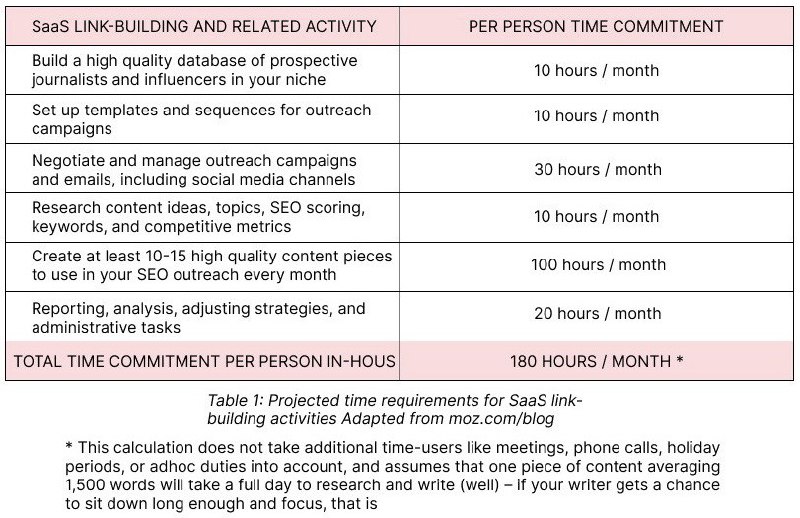In this guide, you’ll learn:
How do you know it’s time to outsource your SaaS link-building?When you’ve done all the work, generated some great content copy, all your SEO is in place, the man-power is accounted for … and you’re still not getting the traffic you need to convert browsers into buyers.
That’s how you know it’s time to outsource your SaaS link-building strategy.
#1: What’s a link-building strategy, anyway?
In line with your organization’s key goals and vision or mission statements, your link-building strategy should ideally take organizational strategies into account.
If your sole goal is to make money on your products, and you’ve been paying for Google ads and still don’t see the results you were hoping for, there’s a good reason for this.
Chances are that no-one is reading your content… or your content is not connecting your products to what people are reading on your site.
low traffic + low visibility + low page score = a page out there on the internet somewhere
Building an online presence takes patience, perseverance, and staying power.
It’s a long-term commitment to incremental success that requires full-time attention.
#2: Why traditional link building strategies don’t always work the way you expect them to
There could be any number of reasons for this, including a lack of calls-to-action, too many redirects, your content is long or unstructured, your ideal customer profile (ICP) is not getting your message, or your SaaS link building processes are not being managed well.
It used to be that a department of 10 managed the same workload that 3 people now manage in most organizations.
The nitty-gritty of your core marketing messages and deliverables (such as SEO alignment, link-building, acquisition metrics, etc) were never supposed to be an add-on task for your content writer, webmaster, or office administrator.
And yet, that’s what happened.
A Jack-of-all-trades now manages your outreach campaigns.
Delivering content at a rate that lets you keep up with everyone else is hard enough; climbing the ranks is harder still.
Doing it with a full plate is impossible.
An effective SaaS link-building strategy eliminates data bias, includes blind spots, takes long-term goals into account, and sets a sustainable SEO strategy in motion that should serve you for all other projects going forward.
The problem?
No-one with a day job has time for this anymore.
That’s why most organizations prefer to use costly link-building platforms that automate the process.
An even bigger problem with this strategy?
As soon as you automate a process, the human brain operating it “switches off” to the nuances, and much like a habit, carries on as before.
The checks and balances you put in place become part of the automated process, too.
This is human bias, a built-in mechanism that downgrades priorities as they become habits.
Who edits the editor, then?
#3: What is link building, anyway?
Link-building is the process of connecting with other like-minded organizations (or individuals) that share a common topic, interest, or goal.
Think of it as SEO networking.
Where networking at events or over long lunches used to connect you to a business prospect or influencer in your market niche, SEO networking (or link-building) now connects you to influencers in your digital environment.
#4: Why you need a SaaS link-building strategy
A creative process, link-building is a complex task that demands not only technical expertise to perfect, but also a hands-on approach that most team members simply no longer have time to focus on.
You could upskill and promote from within, but unless that person’s sole task is to manage your SaaS link-building process, you’re pretty much back at square one while the competition runs circles around your “strategy”.
Simply building links is also not an option.
There is a lot of research and man hours that need to be considered, whether you upskill or delegate from within your organization, or outsource your link-building needs entirely.
Below is a typical overview of the monthly time commitment and tasks-to-do for an average of 10 new links to your website.
Bear in mind that this is an ongoing effort that takes anywhere between 3-6 months to put firmly in place, and an additional 6 months to monitor and tweak.

Even though templates and sequences exist on automated platforms, link-building and outreach campaigns should be a personalized thing, not some one-size-fits-all template you slapped on in a hurry one day.
Yes. I know you need…
You need to suddenly acquire hundreds of authoritative links to your website tonight so you can boost your visibility, ranking, and sales by morning.
To be honest, we need that, too.
#5: Reasons why you should outsource your SaaS link-building strategy
Outsourcing your SaaS link-building needs can do so much for your peace of mind and your business goals.
It can:
- help you foster an organizational environment built on solid knowledge foundations
- allow you to broaden existing SEO campaigns
- create flexibility and time to focus on your core responsibilities
- not force you to hire a new employee or upskill a junior staff member to achieve results.
So, how do you know it’s time to outsource your SaaS link-building strategies?
#5.1 It’s all about timing and placement
As can be seen from table 1 above, an in-house SEO employee has multiple tasks and deliverables to manage on multiple deadlines – alone.
It’s not possible for one person to accomplish every single thing on that list – alone – when they have other commitments or tasks to take care of.
And when they tell you they managed it alone anyway – without support, that is – you need to check their work.
This constant referee thing isn’t worth the frustration and disappointment.
If SEO and link building strategies are not a core function for the person performing these vital tasks, the fundamental quality of your link-building exercises will continue to drop in value over the next few months until there’s little that remains to work on.
#5.2. Hands on, hands off
When core functions are outsourced to freelancers, agencies, or specialists, it frees up your existing resources to focus on what they do best: the jobs they were hired for.
A specialist comes in, does whatever they’re being paid to do, and leaves.
You get focused, intense, and comprehensive support when you need it, but aren’t pressured into handing out odd jobs to keep an employee busy so your monthly wages paid equal the effort investment the employee might have made on link-building.
No drama, no excuses, no delays.
Your only commitment is a financial one.
#5.3. It makes good financial sense
Outsourcing your link-building strategies actually makes more financial sense, and:
- allows you to choose your financial ceiling on costs
- delivers trackable, measurable results
- and links back to the money you’ve invested in your link-building strategies.
time + knowledge + investment = commitment to a goal or strategy
These are also your three biggest challenges in a digital marketing, lead-generation, or link-building strategy.
All the knowledge in the world is irrelevant if no-one is using it or if zero time and money is invested in putting that knowledge to good use.
5.4. It takes the guesswork out of strategy
The enormous amount of pressure attached to the responsibility of promoting projects is overwhelming for one person working alone.
And although most organizations know they need a digital strategy of some sort, they’re really not sure what kind of marketing services they need or what will work best for their specific business case (niche).
This is why a Jack-of-all-trades seems to make more sense at the start of your link-building exercises.
If you’re unsure, what have you lost by using an employee on an adhoc basis?
Nothing … except sustainable market traction and months of wasted time.
In addition, shady tactics and methods that some marketing vendors use leave the industry with a bad reputation and add to the misconception that link-building is best managed in-house or via an online platform that no-one quite understands.
In fact, fully automated link-building exercises add to the months of wasted time because you sit and watch a results page on some system somewhere, hoping someone replied to you by now.
But, hey. The projected numbers look good there, don’t they?
#5.5. It extends and enhances in-house productivity
Importing talent and knowledge is not a strike against employee motivation.
It is the result of long hours of debating whether it makes more business sense to upskill an employee or to import the talent you need to get the job done now.
Outsourcing requires considerable buy-in, not only from your management and executive team, but from the employee on the ground, too.
Trying your best to achieve results that just don’t reflect in the numbers you’re seeing is an incredibly demotivating exercise for some, and even more so when knowledge and know-how is the stumbling block.
The constant stress of doing adhoc link-building (that isn’t working) adds to the demotivation, and results in a lack of productivity.
This is a potential cause for employee burnout.
Is it really worth clinging to this scenario as a strategy?
Using freelancers, agencies, or specialists makes great business sense because it:
- increases your organization’s knowledge base when best practices are shared
- frees up your employees to do their jobs (increasing productivity levels)
- lends credibility and authority to your strategies
- creates a learning environment
- delivers impactful results.
#5.6. It eases the pressure
The pressure of responsibility of promoting projects, pages, posts, products, services, and still being able to deliver on that promise to excellence is enormous.
Outsourcing your SaaS link-building strategy enhances the quality of your current efforts, and eliminates the added pressure to perform.
commitment + productivity – (stress + pressure) = a results-driven organizational environment
#5.7. It eliminates the uncertainty
I get it.
Worldwide pandemics and their fallouts have disrupted business and forced you into a corner you either don’t understand or can’t navigate alone, yet feel forced to keep up with to succeed.
What are your options?
- do it yourself?
- upskill in-house talent?
- or outsource to a professionals.
#6: How do you know you’re (really) ready to outsource your link-building strategies?
It’s important to realize that not every aspect of your SEO and digital marketing strategies would need a dedicated resource to manage them.
SEO is a broad description that covers some very unrelated aspects of the same thing, such as site optimization – which is not keyword optimization – for the same piece of content.
Getting mentioned is a process.
So is link-building.
It’s all about your best content, and just a tiny bit of my in-depth, industry-specific know-how.
You need a personalized SaaS link-building (outreach) strategy that encompasses your organizational – and personal – goals, commitments, and dreams for your business.
Use the sequence below to determine if you’re (really) ready to outsource your SEO link building needs:

Great decision!
This stuff is just magically going to work by itself from now on.
What’s next on your to-do list?
#7: How do you outsource your SaaS link-building – the right way?
When you compare the apparent success of thousands of sites and see the millions of followers, buyers, and jaw-dropping stats they have, it’s pretty easy (and totally disheartening) to think it somehow happened “overnight”.
You may also think this was all just so easy to achieve.
Spoiler alert: links don’t just magically start to come in by themselves.
Someone out there busted their butts off for months to make that happen.
Someone like me.
Heads up, business owners.
While link-building is certainly one part of the process, this single task does not have the power to boost, sustain, or extend your SEO capabilities or strategies.
This is even more true when there are background issues.
#8: Tips to outsource your SaaS link-building – the right way
The most actionable tips are always for those things we take for granted as not being an issue (yet inevitably end up becoming one), such as:
- Technical issues on your website (i.e. outdated plugins, misconfigured measurement tools, etc) that can negatively impact your site’s authority and trust levels.
- Technical issues affect your site’s performance in search engine results (or SERP) and prevent your pages from being crawled and indexed.
Your site won’t even be mentioned in the first 1 million results, never mind the top 10.
- Technical issues interfere with and delay any outreach campaigns you’re considering starting or are in progress with. Why?
Your site just doesn’t measure up to the millions of other sites with far less technical issues – that everyone’s trying to build links to, as well.
- Technical issues include redirects, and while some of these are unavoidable along the way, too many is incredibly bad for your site, delaying content displays and creating anxiety and paranoia while the page waits to load.
Too many redirects prevent connecting to the resource (your site) the consumer just clicked on. The worst part? Your browser tells any visitor who lands there that they’ve been redirected too many times to connect to your page.
Phishing is a real thing these days, and everyone is at risk from malicious content.
Redirects are a red flag to consumers, who see these sites as untrustworthy and even dangerous due to potentially malicious content that constantly gets redirected to avoid firewalls and virus detectors.
- Quality issues with your content (spelling, language use, and grammar, format or display errors, etc) create distrust.
As small as you may think spelling and grammar errors could be, “little” errors like these tell the reader (your ideal customer) that you couldn’t even be bothered to do a spell check or hire an editor to deliver a quality product in anticipation of their needs.
Consumers would rather switch than stay loyal to a brand that disrespects them.
Formatting or display errors are not just bothersome, they’re disruptive, too.
The human brain does not like misalignment at all.
Frustration and disappointment have the same effect on the brain: these emotions lower serotonin, dopamine, and endorphin levels (all those happy chemicals) and deplete your well-being in the moment.
Unhappy customers go somewhere else. It’s as simple as that.
- SEO issues (content not optimized, mobile-first not enabled, etc)
Links from the top domains on the internet can’t drag your site up the ranks if your content is not optimized.
There are a few ways to do this, including:
✔ Know your ideal customer by building personas, which are simply empathetic ways on paper of understanding the consumer’s needs (Yes, there’s some psychology to it).
✔ Build and describe your ideal customer’s buying journey as it relates to your brand so you can anticipate those needs.
✔ Why have you lost customers to competitors? Do you understand your competitors, even?
✔ Natural, contextual key phrases are difficult in some industries (like a spare parts company, for instance), but that’s why you hire a professional writer to do it.
✔ Formatting is vitally important to your rankings: headings, alt text on images, keyword placement, categorization, and more, all tell search engines what your site or page is about.
Without proper formatting and optimization, search engines don’t know how to read or index your page properly.
- Communication issues (fuzzy expectations, failure to communicate, a lack of understanding, etc) create a backlog of unanswered queries, generate feelings of anxiety, and fail to set clear expectations of the anticipated outcomes for both parties.
✔ Be realistically honest.
✔ Discuss your customers’ needs and offer real solutions to their problems.
✔ Answer customer questions about your brand as they weigh up the advantages of investing in you.
✔ If you truly understand your customer, you also understand that they need to know what the best linking opportunities are, too. This isn’t stuff your customers think they need to know. Persevere anyway.
✔ Set a deadline date for deliverables, Mr Nice Guy.
✔ Make sure your link-builder has a clear and transparent process and is willing to walk you through the whole process, including tools and methods that they’ll use to build links.
Both customers and marketers set and expect unrealistic outcomes, which is why they always end up with shady – and shoddy – link building issues.
- Skill issues (poor SOPs, overwhelmed employees, lack of adequate training, etc) again add to frustration levels (on the part of the person trying their best to do this link-building stuff).
Skill issues also:
✘ create unrealistic cultures and environments
✘ are amongst the leading cause of high staff turnover
✘ contribute to employee burnout rates
✘ indicate a lack of management understanding of the core aspects of the business
- ROI issues:
Return on investment (or ROI) is a catch-phrase that’s stuck around a whole lot longer than anticipated and is a metric that’s used for just about anything.
While it has its place in all these things, unless you know how to calculate ROI correctly, it’s just another buzzword the rest of your peers are using to look smarter than you think they are.
A truly manual SaaS link-building strategy that uses only white-hat methods to achieve sustainable and measurable results takes time, a financial investment, and a highly-varied set of skills.
More tips in our link building checklist guide.
Do you have what it takes to do this – alone?
I do.
Do you know how to calculate the myriad of investments you’ve made in this task?
I do.
Even if your specialist calculates all of this for you, it makes absolute business (and personal) sense that you’re able to calculate your own ROI.
You know, just to be sure you’re on the right track.
A great example (though one of the more-simplest of calculations) I use is this one:
X amount of links to your CRM х $X income per user per month
= the amount of customers your link-building efforts need to bring in to cover the cost of building those links
ROI and its metrics, uses, and benefits are discussed in more detail here.
#9: Why white-hat SaaS link-building methods matter?
The words “white-hat” quite literally mean “ethical” and are a throwback reference to old spaghetti Westerns, where the good guys wore white hats to a shoot-out, and the bad guys wore black hats.
How does this relate to SaaS link-building processes and methods?
Glad you asked!

#10: What are my GetMentioned. Today white-hat SaaS link-building methods?
I use my clients’ best content for personalized outreach.
I leverage this to get you the most relevant and industry-specific links on the market.
What you get is white-hat, high-authority backlinks that boost your website’s SERP rankings and cater to a wider, tightly-targeted audience through organic lead acquisition.
And as you know, search engines like Google are all about the organics of search.
My personalized link-building and outreach campaign processes (yes, they’re different concepts) manage your entire SaaS link-building campaigns, goals, and ROI reporting:
✔ I only follow white-hat SaaS link building methods and avoid sites that offer or sell low quality and irrelevant links
✔ I look for link opportunities from organizations that can build your brand reputation and display real respect for their audience
✔ I offer mutually-beneficial and reliable (non-monetary) value by providing great content, tips, suggestions, and useful links
✔ I build sustainable and authoritative back-link sources for your brand that aren’t generated from pushy offers, cold pitches to the wrong people, or off-the-books payments
✔ I respect my clients, my network, my efforts, and my commitment to your brand.
#11: My GetMentioned. Today white-hat SaaS link-building workflow

#12: How do my GetMentioned. Today white-hat SaaS link-building methods benefit YOU?
- I communicate closely with your SEO/Marketing team to сombine efforts and maximize outcomes
- I find niche-relevant, legit sites
- I perform a personalized outreach campaign
- I negotiate links with site owners, journalists or staff writers, editors, influencers, and relevant stakeholders
- I make strategic suggestions and offer valuable advice to all parties in the SaaS link building process
- I compile detailed reports that contain relevant, actionable insights.
- I deliver on my commitment to your success.
Still not convinced my services are right for you?
Use the workflow below to answer the original question I asked you.








 View another articles
View another articles